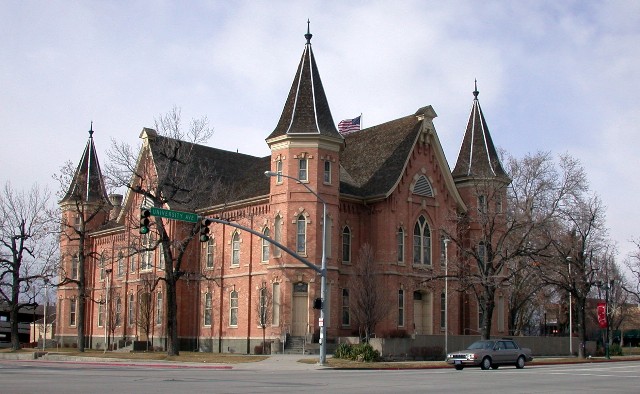During the first months of 1869, the valley to the east of the Promontory Mountains was filled with construction camps of the Union Pacific and Central Pacific Railroads. Many of these camps became short-lived "Hell-on- Wheels" towns with names like Deadfall, Last Chance, and Junction City. Today, virtually nothing remains of these construction camps, however, the workers' legacy of a hand built railroad has been preserved.
Hiking the 1 1/2 mile loop trail will allow you to see first-hand some of the railroad's most difficult hand-hewn achievements, including the Central Pacific's Big Fill and the site of the Union Pacific's Big Trestle.

The Big Fill was an engineering project on the First Transcontinental Railroad in the U.S. state of Utah. To avoid a costly 800 feet (240 m) tunnel through mountainous terrain east of Promontory Summit, Central Pacific engineers mapped an alternate route that still needed to span a deep ravine.
Over two months, 500 workers hauled more than 10,000 cubic yards of material to build the rail bed. At its extent, the fill extended for 500 feet (150 m) and up to a depth of 70 feet (21 m).


Within sight of the Big Fill, the Union Pacific line was also attempting to cross the ravine. The Union Pacific was several months behind Central Pacific, and opted to build a wooden trestle instead of using an earthen fill.

The Big Trestle was built in 36 days. Six months after the completion ceremony, Central Pacific was awarded control of the line from Promontory to Odgen. They opted to take the rail from the poor quality Big Trestle and move it to the Big Fill, which remained in use until the rails were removed in 1942. Today both sites are part of the Golden Spike National Historic Site where a walking trail allows visitors to see the Big Fill and the remains of the Big Trestle.

This view is looking south down Spring Creek ravine from the Central Pacific's upper grade. On the left and right of the ravine are the eastern and western abutments of Big Trestle.

Looking west along Big Fill. The South Promontory Mountains are on the horizon. To the left is Great Salt Lake. This view provides a clear view of the abutments of Big Trestle.

Not since tunneling through the Sierra Nevada did the Central Pacific confront such a rugged landscape. This portion of the railroad also represents the most grueling construction the Union Pacific undertook form Omaha to Promontory.

Grading crews could work up to 300 miles ahead of track laying crews. A meeting point had not been mandated to the companies and they had no incentive to cease construction as their work crews drew closer to one another. Consequently, they built grade past each other for 250 miles. When a meeting point was finally agreed upon, both companies discontinued grading beyond Promontory Summit. All along the trail there is both complete grade and partially constructed grade.
Central Pacific's grade is the upper grade and the Union Pacific's is the lower grade.


Rock cuts and fills had to be constructed along the route to bring it within the required grade of 2 percent or less. Cuts were made to create fill by a two man team called "double jackers", who drilled holes in solid rock using a long, narrow drill bit, which was repeatedly struck with a heavy sledge hammer or double jack.

After the hole was drilled, a worker called a "powder monkey" would fill it with black powder, carefully tamp and fuse the powder, and set off the charge. A successful blast would reduce rock to a size that could be shoveled into mule-drawn dump carts and taken to an area that needed to be filled.

When debris from construction of rock cuts wasn't needed, the rock was dumped into mounds called spoils piles. The piles were size-graded, featuring different sizes of rocks.
This harsh terrain was home to thousands of railroad workers during the final days of the railroad's construction. Several Union Pacific camps were scattered in the valley below and although many of these camps maintained reputations as "hell-on-wheels" towns, only Deadfall held this distinction in the Promontory area.
Deadfall at Promontory - An Archaeological Mystery
Tents at Promontory 1869 This tranquil photograph of Union Pacific's Deadfall belies its rough and raucous reputation. (A.J. Russell photo)
This tranquil photograph of Union Pacific's Deadfall belies its rough and raucous reputation. (A.J. Russell photo)The present day buildings in the distance are part of the ATK Launch Systems Group complex on Utah 83.



Central Pacific's biggest problem: how to cross Spring Creek Ravine. Imagine placing the first small, mule-drawn dump cart load of fill at the bottom of the ravine. The work took over 2 months of intense effort by 250 dumpcart teams and more than 500 workers, totalling more than 101,000 cubic yards.
To span Spring Creek Ravine, the Union Pacific constructed the Big Trestle, which was located 150 feet east of hte Big Fill. Because it meant to be a temporary structure, construction of the Big Trestle took only 36 days. The trestle was 85 feet high and 400 feet long.
 (NPS PHOTO)
(NPS PHOTO) About 8 months after completion of the transcontinental railroad, the Central Pacific gained control of the route from Promontory Summit to Ogden, Utah and trains began using the Big Fill rather than the Big Trestle.
Heading east past the site of the Big Fill and the Big Trestle, one passes through Carmichael's cut and then the wildlife becomes abundant.

This Great Basin Whiptail Lizard was almost invisible with his surroundings.

The "Cnemidophorus tigris tigris" is a terrestrial lizard of arid and semi-arid deserts to open woodlands where vegetation is sparse enough to make running easy. Their movements are rapid and jerky. They are among the most difficult lizards to capture.
Then two hawks began circling above.

Perhaps they were looking for lunch or maybe protecting something above me in the rocks.

Various shelters are scattered throughout the Promontory Mountains. They may have been used as a cache for construction materials or as shelter during blasting

Heading east around the next bend, more of ATK Launch Systems becomes visible across the valley.


The Promontory Mountains watched over the achievements of those who labored here. These achievements remain preserved at Golden Spike National Historic Site as a tribute to the perseverance and talents of all who worked to complete an engineering marvel and open a new chapter in our nation's history - the era of the railroad.
The Promontory Mountains continue to loom over the sprawling, isolated ATK facility, builders of NASA space shuttle rocket motors.

The plant, once designated as "Air Force Plant 78", once employed over three thousand people, who worked in 450 buildings, clustered in the various industrial and test areas that are scattered throughout the bare hills of the 30 square mile complex.



In 2001 Thiokol's propulsion division was acquired by Alliant Techsystems, a weapons and explosives manufacturer that operates a large plant outside Salt Lake City, the Bacchus Works.


ATK Launch Systems now faces a time of uncertainty and since April 2009, more than 1,900 people have left the company, voluntarily or otherwise, after defense and aerospace cutbacks in the shuttle and other missile programs.

 Flames tore through the iconic building last Friday morning, gutting the interior. Debris piled 9 feet high covers the floor. The outside brick walls remain standing.
Flames tore through the iconic building last Friday morning, gutting the interior. Debris piled 9 feet high covers the floor. The outside brick walls remain standing. 
















































